The Baltic Coastal Hiking Route
Lari McDonald & Hedley Amos, WA
Bibbulmun Track stalwarts Hedley Amos and Lari MacDonald walked the Baltic Coastal Route in June-July-August 2022. This is an account of their trip:
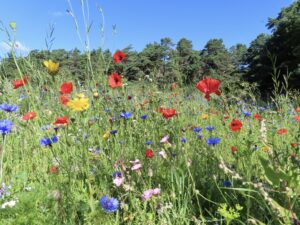
Wildflowers in the meadow.
The 1419km Baltic Coastal Hiking Route forms part of the E9, one of Europe’s long-distance paths, which runs for 9880 km from Tarifa, Spain to Narva-Jõesuu in Estonia. The Baltic Route begins at the Kaliningrad/Lithuanian border on the Curonian Spit, heads north through Lithuania and Latvia and finishes at Tallin in Estonia. It takes around 70 days to complete.
As the name suggests this is a coastal route, passing along lovely firm beaches by the Baltic Sea. It’s easy to enjoy a mostly obstacle free beach with the occasional creek outlet. One of the wonderful things about this trail is a forest option that provides shade and shelter from wind and is never much more than 100m from the beach. The hiker can simply bounce back and forth between beach and forest at will.
More than 50% of the Baltics consists of beautiful forests, predominantly coniferous with scattered beech and birch trees. The trail is essentially flat, with a maximum elevation of 66m and there are plenty of opportunities to watch sunrises, sunsets, and to swim. In one section of the forest we found remnants of the old iron curtain fence. not uncommon in the old eastern bloc countries.
Hikers also have the option to explore the West Estonian Islands, which are easily accessible by ferry. Some of the islands have free buses for touring around the island, or bicycles that can be hired for the day.
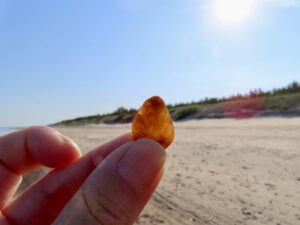
Amber found everywhere on the beaches.
Through the Estonian section the beaches frequently become impassable due to reed beds and the trail passes through fields filled with stunning flowers, termed wildflowers locally but which are often flowers that are tended with loving care back here in Australia!
Walkers can forage for blueberries, blackberries and lingonberries along the forest trails and scout the water’s edge for amber, which washes up along a large part of these shores, especially through the Latvian section. A legend has it that a princess lived underwater here in an amber castle. She married a commoner and her father was so angry he shattered her castle and that is why there is amber washing up on the shores.
There are many deer, foxes and squirrels in the forests. The only wildlife to be concerned about are the Baltic Airforce or black flies that are prolific at times and bite as if they haven’t feasted for ages. If you stop moving for five seconds, you can’t see your skin. One day in the forest it was so bad we bolted for the beach, jumping logs and ducking under branches at breakneck speed as they swarmed us all the way. Picture Winnie the Pooh after he’s raided a hive with a stream of bees behind him and you’ll get it.
The only wildlife to be concerned about seriously are ticks, as these can cause encephalitis and it is well worth organising a vaccination for when you arrive. The cost of organising this in the Baltics is about 10% of the cost and lengthy lead in time if you to do it in Australia.
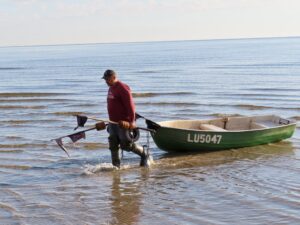
Bringing in the catch.
In the early mornings, you will see fishermen bringing in their catch for the day as they have done for decades. The Baltics, previously part of the Soviet Union, still show many remnants of the austere lifestyle the people have lived with for decades. There are beautiful and ancient buildings; mostly wooden, and many with thatched roofs. Many people still live a very simple life and one of the wonderful things about hiking here is experiencing such a different culture.
Camping is easy with campgrounds along the way with water and toilets and many of them are free. Most have firepits and they all provide serenity as you sleep peacefully through the night listening to the sounds of the forest or the lapping waves of the Baltic Sea. There are many options for family stay accommodation for those nights that you want to sleep inside and get to know and understand the local culture. We had a great experience one night with nowhere to camp or stay when a lovely lady offered us a small room in a disused but still functional church she had bought to set up for hikers.
Hikers can also find plenty of options for food resupply at many small shops along the trail. As a bonus for coffee lovers, there are vending machines everywhere and they pop up on beaches and forests in the middle of nowhere. Toilets are plentiful and appear wherever you cross roads or are near popular areas.
The cities of Riga in Latvia and Tallinn in Estonia are well worth a couple of days visit. These cities are rich in history and there are many free tours in English. The people throughout the Baltics are friendly, most speak English and love to spend time with you — you can learn so much from them.
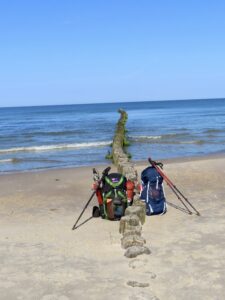
The western most point of Latvia
Thanks to a large grant received for the marketing of this trail, there are free maps and guides available online that give all the information you need to take this beautiful hike on a trail less travelled. By comparison to other parts of Europe this region is relatively inexpensive to travel through.
There are many options to get to the trail from any major city in Europe – you just need to get to Riga in Latvia or Vilnius in Lithuania and take a bus from there to the kick off point. We chose to fly from Perth to Helsinki to visit a hiking friend in the archipelago for a few days, then flew on to Riga.
For more information go to: https://baltictrails.eu/en/coastal
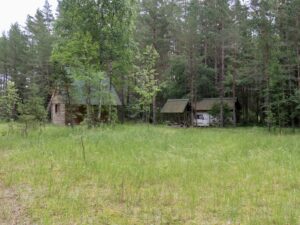
Old buildings in the forest.

